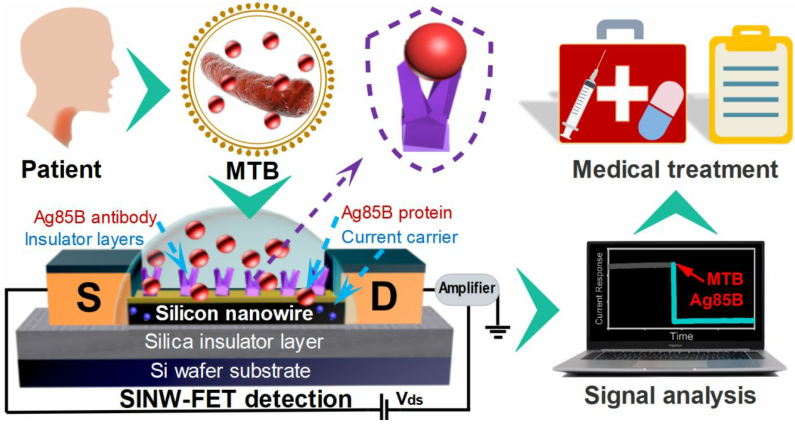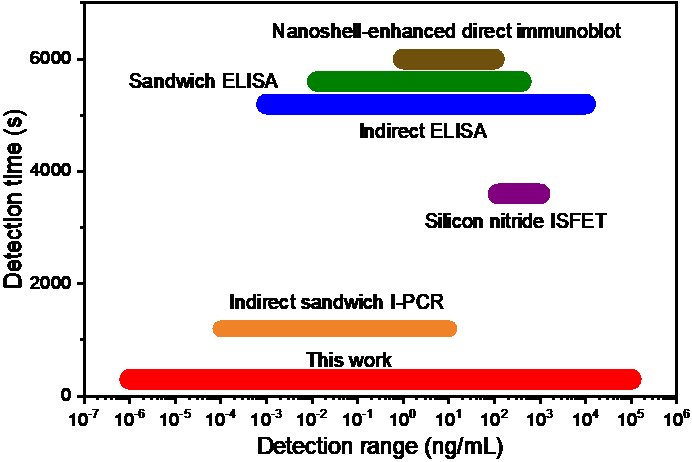Tuberculosis (TB) is a kind of infectious disease transmitted by respiratory tract. It is mainly transmitted by human pathogens Mycobacterium tuberculosis (MTB) through human transmission. It has high incidence rate and high mortality rate. The 2020 Global Tuberculosis Report released by WHO shows that about 1/4 of the world's population is infected with MTB, and 1.41 million people died of TB in 2019. However, most of the traditional MTB detection methods are complex, time-consuming and with low sensitivity, and require complex equipment and high operation skills, posing challenges for rapid screening.
Recently, a research team led by Professor Can Wang at the School of Environmental Science and Engineering has developed a new type of silicon nanowire field effect tube (SiNW-FET) biosensor for rapid and sensitive detection of MTB. The Ag85B protein, a typical MTB marker, was selected as the target to be detected. The surface functionalization parameters of the biosensor were explored and optimized, and the best-operating conditions were obtained. The SiNW-FET biosensor has good sensitivity, reproducibility and stability. The LOD of MTB Ag85B protein is 0.01 fg/mL, and there is a linear relationship between the current signal and the protein concentration in the range of 1 fg/mL-100n µg/mL, which can be initially used for quantitative detection. The entire test cycle can be completed in as soon as 30 seconds.
Clinical samples were used to further test the performance of the biosensor. The NALC-NaOH method is used for standard pretreatment of the sputum of TB patients, and the signal can be detected in the range of five dilution gradients and shows a linear trend. Conventional MTB detection methods BECTEC MGIT 960 automatic culture system and ELISA were used to verify the corresponding sample and there is no significant difference. However, the automatic culture system requires at least 15 days of culture, ELISA requires 5 hours of testing time and the detection concentration range is small.
What's more, this method directly uses unpretreated sputum to detect and achieves a better distinction between healthy people and TB patients, which greatly shortens the TB detection time (considering the dilution of sputum, only 2-5 min) . Compared with other methods, the SiNW-FET biosensor can detect MTB in a wider concentration range in a shorter time. This technology provides a new idea and method for rapid screening of TB patients.
The paper was published online in the journal ACS SENSORS (IF=7.711) under the titleRapid and Sensitive Detection of Mycobacterium tuberculosis by an Enhanced Nanobiosensoron September 2, 2021. Jinbiao Ma, a master student is the first author. The co-corresponding authors include Professor Wang, Can from Tianjin University, Senior engineer Xie Xinwu from the, Academy of Military Sciences, Professor Tie Li from the Chinese Academy of Sciences, and Associate Professor Xiaohong Zhou from Tsinghua University.
Paper link:https://doi.org/10.1021/acssensors.1c01227
Professor Can Wang’s team is building a fully automatic detection system, and the detection of respiratory pathogenic microorganisms expected to be as convenient as a drunk driving screening. Through the functionalization of different biological materials, this type of biosensor can also be used for other infectious diseases, such as the initial screening of COVID-19.

Figure 1. Flow chart of MTB rapid screening

Figure 2. Comparison of the effects of different biotechnologies in detecting MTB Ag85B
By the School of Environmental Science and Engineering
Editor: Yang Fan & Eva Yin






